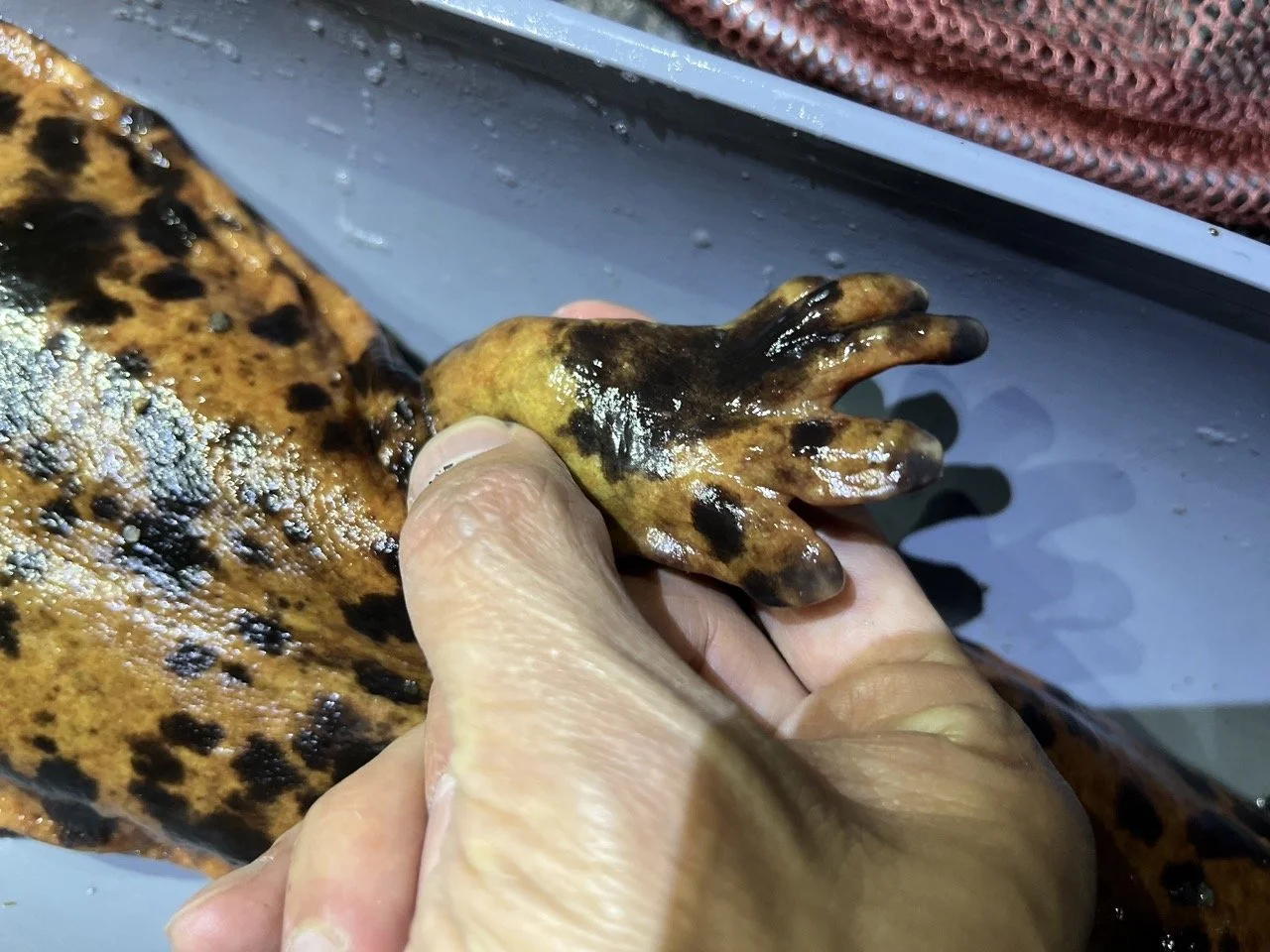Japanese Giant Salamander Conservation Experience
The World’s Only Non-Intrusive Salamander Experience — Supporting Real Conservation Efforts
Tour Itinerary
1:00 PM – Meet at Mikuriya Station
Meet at the station and drive a short distance to our Japanese Giant Salamander Research Base. Here we will have with a short introduction and safety briefing as well as fitting the waders.
1:45 PM – Field Visit: Contrasting Environments
Visit both a disturbed site and a largely pristine habitat to gain a deeper understanding of the challenges and successes in Japanese Giant Salamander conservation. Learn about ongoing initiatives, including bypass-ramp construction and organic farming practices in sensitive areas. We will also keep an eye out for other wildlife that calls the Daisen region home, including local herpetofauna, birds, and mammals.
If time allows, we will also visit an ancient irrigation tunnel to observe a small bat colony — another fascinating resident of the area.
4:30 PM – Return to Mikuriya
Enjoy a detailed presentation covering the salamander’s biology, the threats it faces, and the conservation strategies being implemented.
5:30 PM – Dinner Break
Depending on the day, there are several excellent local dining options. See below for an optional special dinner experience.
6:45 PM – Night Surveys or Viewing Experience
The evening activity will be determined by the Japanese Giant Salamander expert guide based on the relevant research licences and permits, as well as local and seasonal conditions.
Night Survey (Research Activity)
Join your guide for a nocturnal river survey. When salamanders are located, some may be gently netted and placed in a measuring tube. For selected individuals, biometric data—such as total length, weight, and general condition—may be recorded. Where appropriate, animals will be scanned for existing PIT tags or fitted with a new microchip before being safely released. Depending on environmental conditions and animal behaviour, not all individuals will be handled.
OR
Japanese Giant Salamander Viewing Experience (Low-Impact Research & Observation)
Join your guide for a low-impact viewing experience in a pocket of beautiful, rare natural habitat. While our focus is on observing salamanders in a natural, undisturbed state, we also contribute to ongoing conservation monitoring. This may include simple water-quality checks and recording observational data on habitat conditions or salamander presence. All activities follow strict protocols designed to minimise disturbance.
The rivers are a stunning place to spend the evening, and there is a good chance of encountering other amphibians, reptiles, and river-dwelling wildlife along the way.
10:30 PM – Return to Mikuriya Station
You’ll return in time to catch the last trains to Yonago and Kurayoshi.
Price
1 person: 55,000 yen
2 people: 70,000 yen
35,000 yen per additional person (up to 6 people total)
Optional dinner options:
1) Vegan or Vegetarian Bento Box:
Enjoy a freshly prepared vegan or vegetarian bento box made by a trusted local producer. Ingredients are locally sourced, predominantly organic, and can be made gluten-free upon request. If eggs are included, they come from our own free-range chickens. Subject to availability; pre-ordering is required.
Price: 3000 yen per person
2) Special Dinner at Mikuri
For an unforgettable dining experience, we highly recommend Mikuri — a beautifully restored traditional restaurant. The chef, trained in French cuisine, offers a refined fusion of French and Japanese dishes using seasonal, locally sourced ingredients.
Dinner Courses (tax included):
Shiro – 5,280 yen
Mizu to Hakari – 7,480 yen
Mikuri no Shin – 16,500 yen
Instagram: Mikuri
If you’d like your guide to join you for dinner to help interpret the chef’s explanations and offer deeper context, that can be arranged—just kindly cover the cost of the guide’s meal. (The chef doesn’t speak English, but the flavour speaks for itself!)
Other dining options in the area include excellent ramen, udon, pasta, and a simple canteen-style eatery (availability varies by day).
Additional Information
Group Size: 1–6 people (Contact us to arrange a special program for larger groups)
Age Limit: 7 and older (For children under 7, please enquire about special arrangements)
Season: April to November
Included:
Wader rental
Transport from Mikuriya Station to field sites and back
What to Bring:
Headlamp or flashlight (waterproof recommended) and spare batteries
Warm, weather-appropriate clothing
Dinner or snacks (if not joining the Mikuri dinner)
How to Book
First, email Richard Pearce at richard@bushidojapan.com or use the CONTACT button above to check availability.
Once confirmed, complete your booking in four steps:
Sign and return the terms & conditions document
Make full payment via Wise transfer (link provided after confirmation)
Provide full names and ages of all participants
Provide shoe sizes for wader rental
Accommodation Suggestions
Most guests stay in Yonago and take the train to Mikuriya. A popular budget option is Guesthouse Hatabou in Daisen Town, bookable via Airbnb.
Click here for our full guide to local sights, nature walks, cultural sites, and seasonal highlights in the Mount Daisen area.
Contact
For enquiries and bookings in English:
📧 richard@bushidojapan.com
Booking Conditions
Full payment is required once availability has been confirmed.
Cancellation fees apply as follows: (Once a booking is confirmed and payment is made, a cancellation fee applies)
20% — For cancellations made up to 15 business days before the activity (by 17:00 JST)
30% — For cancellations made 7 to 2 business days before the activity
50% — For cancellations made 2 to 1 business day before the activity
100% — For cancellations made after 17:00 on the business day before the activity
Checking the feet of a Japanese Giant Salamander
The salamanders of the Nawa River Basin and their significance to Japanese Giant Salamander Conservation
The Nawa River basin is a special habitat for the JGS. It is unique in that it has relatively large numbers of JGS at a low altitude (of 100 meters or less) and also so close to the ocean. Elsewhere in Japan only small numbers of salamanders can be found at such low altitudes. The reason for the high concentration of JGS in the Nawa River basin is because of its location on the northern slopes of Mount Daisen, a sacred mountain situated on the Sea of Japan coast. The beech forests on the mountain’s slopes are largely intact and act as important water filters for the surrounding area. Combined with the high annual precipitation, the abundance of nutrient rich water in the rivers, soil and fisheries make Daisen a potential haven for wildlife.
However, according to leading researchers, if urgent measures are not taken soon the Japanese giant salamanders in this special habitat will die out. Being present at lower altitudes naturally places the salamanders at a closer proximity to humans. Increased development in the basin has led to the rivers and streams being fragmented or blocked by the construction of roads, weirs, and dams. Pollution from agricultural runoff is also effecting the quality (particularly the oxygen levels) of the water in which the salamanders live.
Charitable donations and financial support from the private sector are increasingly necessary in order to continue research and protect the future of the Japanese giant salamander. The Daisen Japanese Giant Salamander Conservation Experience aims to generate data to contribute to the salamanders' conservation through limited, select participation, carried out under strict ethical guidelines.
Daisen Town is 30 mins by car from Yonago City. Flights to Yonago Airport from Tokyo Haneda take around 80 minutes. Local trains connect JR Yonago Station and Mikuriya Station in around 27 minutes. Pick-up and return can be provided from Mikuriya Station.
Conservation
Japanese giant salamanders became a nationally protected species under the "Special Natural Monument" designation in 1952, and its conservation status was recently raised to "vulnerable" from "near threatened" in the Japanese Ministry of Environment's Red Data Book. The probability that this species will become extinct is increasing because of habitat loss and degradation associated with human activity, such as dams and bank protection walls. These alterations contribute to habitat fragmentation and the elimination of nest sites of the salamanders.
Local status
The Nawa River basin, which flows down the Northern slopes of Mt. Daisen, are an important and special Japanese giant salamander habitats. However, there is a severe lack of data and the habitat itself receives no official protection. The data collected during these tours is vital in understanding the true situation for the JGS in the Nawa River Basin.
Japanese Giant Salamander
The Japanese giant salamander is one of only three members of the Cryptobranchidae family. Their biology has changed little in millions of years, earning them the title of “living dinosaurs”. The Japanese giant salamander is the second largest in this family, can grow up to 1.5 meters in length, and potentially live up to a hundred years. They are generally active at night, relying on smell and touch to locate prey, which includes fresh-water crab, fish, frogs and insects, catching them with a rapid sideways snap of the mouth. It has an extremely slow metabolism and can go for several weeks without eating. This species’ large size and lack of gills in fully developed adults are thought to confine them to cold, fast flowing water where oxygen is in good supply.


